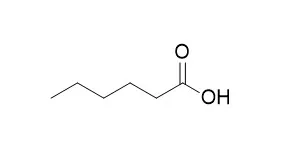| In vitro: |
| Frontiers in Plant ence, 2014, 5(488):488. | | Priming of plant resistance by natural compounds. Hexanoic acid as a model.[Pubmed: 25324848] | Some alternative control strategies of currently emerging plant diseases are based on the use of resistance inducers. This review highlights the recent advances made in the characterization of natural compounds that induce resistance by a priming mechanism. These include vitamins, chitosans, oligogalacturonides, volatile organic compounds, azelaic and pipecolic acid, among others. Overall, other than providing novel disease control strategies that meet environmental regulations, natural priming agents are valuable tools to help unravel the complex mechanisms underlying the induced resistance (IR) phenomenon.
METHODS AND RESULTS:
The data presented in this review reflect the novel contributions made from studying these natural plant inducers, with special emphasis placed on Hexanoic acid (Hx), proposed herein as a model tool for this research field. Hx is a potent natural priming agent of proven efficiency in a wide range of host plants and pathogens. It can early activate broad-spectrum defenses by inducing callose deposition and the salicylic acid (SA) and jasmonic acid (JA) pathways. Later it can prime pathogen-specific responses according to the pathogen’s lifestyle. Interestingly, Hx primes redox-related genes to produce an anti-oxidant protective effect, which might be critical for limiting the infection of necrotrophs.
CONCLUSIONS:
Our Hx-IR findings also strongly suggest that it is an attractive tool for the molecular characterization of the plant alarmed state, with the added advantage of it being a natural compound. | | J Plant Physiol,2011 Mar 1;168(4):359-66. | | Priming for JA-dependent defenses using hexanoic acid is an effective mechanism to protect Arabidopsis against B. cinerea.[Pubmed: 20950893] |
METHODS AND RESULTS:
Soil drench treatments with Hexanoic acid can effectively protect Arabidopsis plants against Botrytis cinerea through a mechanism based on a stronger and faster accumulation of JA-dependent defenses. Plants impaired in ethylene, salicylic acid, abscisic acid or glutathion pathways showed intact protection by Hexanoic acid upon B. cinerea infection. Accordingly, no significant changes in the SA marker gene PR-1 in either the SA or ABA hormone balance were observed in the infected and treated plants. In contrast, the JA signaling pathway showed dramatic changes after Hexanoic acid treatment, mainly when the pathogen was present. The impaired JA mutants, jin1-2 and jar1, were unable to display Hexanoic acid priming against the necrotroph. In addition, Hexanoic acid-treated plants infected with B. cinerea showed priming in the expression of the PDF1.2, PR-4 and VSP1 genes implicated in the JA pathways. Moreover, JA and OPDA levels were primed at early stages by Hexanoic acid. Treatments also stimulated increased callose accumulation in response to the pathogen. Although callose accumulation has proved an effective IR mechanism against B. cinerea, it is apparently not essential to express Hexanoic acid-induced resistance (HxAc-IR) because the mutant pmr4.1 (callose synthesis defective mutant) is protected by treatment.
We recently described how Hexanoic acid treatments can protect tomato plants against B. cinerea by stimulating ABA-dependent callose deposition and by priming OPDA and JA-Ile production.
CONCLUSIONS:
We clearly demonstrate here that Hx-IR is a dependent plant species, since this acid protects Arabidopsis plants against the same necrotroph by priming JA-dependent defenses without enhancing callose accumulation. |
|






 Cell. 2018 Jan 11;172(1-2):249-261.e12. doi: 10.1016/j.cell.2017.12.019.IF=36.216(2019)
Cell. 2018 Jan 11;172(1-2):249-261.e12. doi: 10.1016/j.cell.2017.12.019.IF=36.216(2019) Cell Metab. 2020 Mar 3;31(3):534-548.e5. doi: 10.1016/j.cmet.2020.01.002.IF=22.415(2019)
Cell Metab. 2020 Mar 3;31(3):534-548.e5. doi: 10.1016/j.cmet.2020.01.002.IF=22.415(2019) Mol Cell. 2017 Nov 16;68(4):673-685.e6. doi: 10.1016/j.molcel.2017.10.022.IF=14.548(2019)
Mol Cell. 2017 Nov 16;68(4):673-685.e6. doi: 10.1016/j.molcel.2017.10.022.IF=14.548(2019)